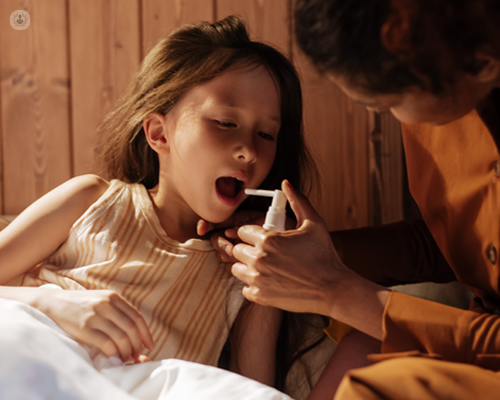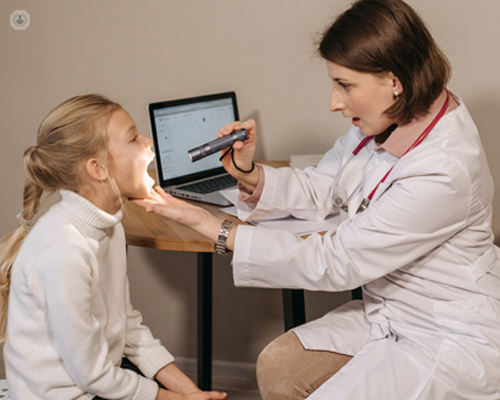Scarlet fever
Dr Jibu Varghese - Dermatology
Created on: 04-01-2019
Updated on: 03-29-2023
Edited by: Aoife Maguire
What is scarlet fever?
Scarlet fever, also known as scarlatina, is a bacterial infection caused by the bacteria group A Streptococcus or group A strep. The condition is characterised by a red rash covering most of the body. Most patients also experience a sore throat and fever.

What causes scarlet fever?
Scarlet fever is caused by a type of bacteria which also causes strep throat, and appears after the symptoms of strep throat are already apparent. The rash characteristic of scarlet fever is caused by toxins that are produced by the infection-causing bacteria.
What are the symptoms?
The first signs of scarlet fever are usually a high fever and swollen neck glands, which can cause difficulty with swallowing. Occasionally, patients will experience nausea, vomiting, or headaches. After a few days, symptoms also include:
- a red rash, starting from the chest, which eventually covers most of the body apart from the face
- redness in the folds of the skin, that are a deeper red than the rashes
- a flushed face
- a red and bumpy tongue
- itching
The rash symptoms will last for approximately a week and once they have subsided, the skin may peel.
What do scarlet fever rashes look like?
The rash appears red, small, raised bumps and feels coarse to the touch. It is easier to see on lighter skin tones, but it can be felt on darker skin tones. While the face remains rash free, it can be red in colour.
Who is most at risk of scarlet fever?
In most cases, scarlet fever affects children aged 5 to 15 who contract it from the others around them in school. Although children are most likely to get scarlet fever, in rare cases it can affect adults, particularly adults who are frequently in contact with children. In most cases, adults will have built up the antibodies to protect themself from the bacteria. The symptoms of scarlet fever are the same in children and adults.
How is scarlet fever diagnosed?
If a child has a sore throat, high fever, swollen glands and a body rash it is important to bring them to their GP. Scarlet fever diagnosis is very quick and involves two steps:
- A physical examination, during which the doctor will check your skin for signs of a rash, your neck for signs of swelling, and your tongue for bumps.
- Throat swab to take a small sample of saliva from the throat to be tested quickly for the bacteria that causes scarlet fever.
- Sometimes the GP might arrange a blood test to check for infection elsewhere.

How do you prevent scarlet fever?
You can reduce your risk of getting scarlet fever by reducing contact with bacteria from other people. Easy steps to reduce your risk include:
- washing your hands before and after eating meals, and whenever you go to the toilet
- covering your mouth when sneezing or coughing
- not sharing food, cutlery, utensils, food or drinks
- if someone around you has scarlet fever, every surface they come in contact with should be disinfected
How is scarlet fever treated?
Scarlet fever can be treated by taking antibiotics. These should cure you of scarlet fever within a week. It’s common for your symptoms to go away faster than this, but it is important to take the full course of antibiotics or the symptoms may come back.
In the meantime, you can relieve the symptoms by taking painkillers and avoiding throat pain by drinking cold drinks and eating soft foods. To reduce the urge to itch, antihistamine tablets or lotions can help.
A child who is taking antibiotics can generally return to school after 24 hours of taking their first antibiotic, as they will no longer be contagious.
Is scarlet fever contagious?
Scarlet fever is a contagious disease because the infectious bacteria are found in the nose and throat, meaning it is very easily spread from person to person.
What complications can arise from scarlet fever?
If scarlet fever is not treated with antibiotics, the bacteria can spread through the body and cause conditions such as:
In severe cases, which rarely occur, scarlet fever can progress to rheumatic fever, which is a serious condition that can affect the heart, joints, nervous system, and skin.
Is scarlet fever fatal?
Scarlet fever was once a dangerous childhood illness, but antibiotics have been crucial in improving the prognosis. In modern society, scarlet fever does not usually cause complications, particularly if it is treated in the correct manner.
There may be a small risk of infection spreading, which can lead to other infections such as ear infections and in some rare cases, it may lead to complications at a later stage such as meningitis. However, the risk of these complications arising is rare.
